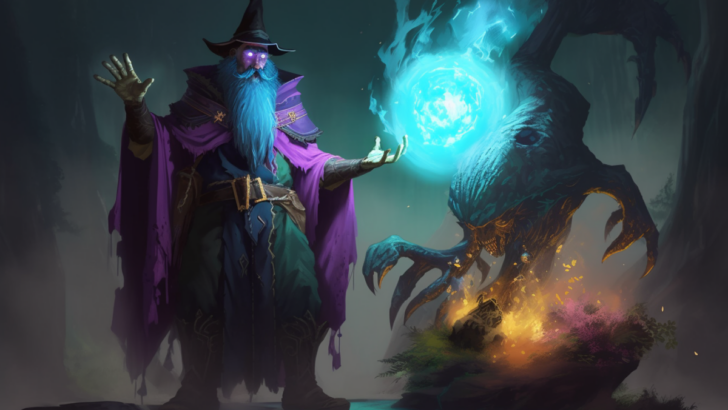Polymorph is a wacky, powerful spell that can lead to interesting solutions for players and headaches for DMs everywhere.
That being said, it is widely popular for its versatility and creative opportunities. Always a fan favorite, Polymorph is a staple for many arcane masters, and rightfully so.
The rules for Polymorph are found in the Players Handbook on page 266.
Contents
Polymorph 5e
4th-level Transmutation
Casting Time: 1 Action
Range: 60 Feet
Components: V, S, M (A caterpillar cocoon)
Duration: Concentration (1 Hour)
This spell transforms a creature that you can see within range into a new form. An unwilling creature must make a Wisdom saving throw to avoid the effect. The spell has no effect on a shape changer or a creature with 0 hit points.
The transformation lasts for the duration or until the target drops to 0 hit points or dies. The new form can be any beast whose challenge rating is equal to or less than the target’s (or the target’s level if it doesn’t have a challenge rating).
The target’s game statistics, including mental ability scores, are replaced by the statistics of the chosen beast. It retains its alignment and personality.
The target assumes the hit points of its new form. When it reverts to its normal form, the creature returns to the number of hit points it had before it transformed.
If it reverts as a result of dropping to 0 hit points, any excess damage carries over to its normal form. As long as the excess damage doesn’t reduce the creature’s normal form to 0 hit points, it isn’t knocked unconscious.
The creature is limited in the actions it can perform by the nature of its new form, and it can’t speak, cast spells, or take any other action that requires hands or speech.
The target’s gear melds into the new form. The creature can’t activate, use, wield, or otherwise benefit from any of its equipment.
The rules for the Polymorph spell show that it has the potential for offensive and defensive capabilities, in addition to use outside of combat.
The wisdom saving throw to ignore the effects make it a risky play against enemies at a 4th level slot, but the payoff should definitely be worth it. A key item to note is that if the creature’s new form drops to 0 hit points, it reverts back to its original form.
What Can I Polymorph Into?
The rules for Polymorph state that you can assume the form of any beast with the challenge rating or level restrictions in place. Monsters have clearly defined categories under which they fall. A dragon is not a beast – it is a dragon, a skeleton is not a beast – it is undead.
This doesn’t mean the spell is useless, however. Several great options are still available, depending on what your goal or objective is. Traveling quickly on land, traveling by flight or underwater, combat, climbing, espionage, and blending in are all possible in different forms using Polymorph.
You also assume the abilities and characteristics of the beast you choose. This makes darkvision, flight, and swim speed possible. It can also give you other advantages such as pack tactics, burrowing, grappling, and advantage on certain skill checks, such as perception, which are based on senses.
Below are some great example options provided you meet the challenge rating/level restriction.
- Giant Ape CR 7 -great hit points (157), Athletics +7 (climbing and grappling), Passive perception 14, Multi-attack (2 Fist, 3d10+6)
- Giant Bat CR ¼ – Fly Speed 60 ft, Blindsight 60 ft, Keen Hearing (Advantage on perception checks using hearing)
- Elk CR ¼ – Speed 50 ft, Charge
- Giant Eagle CR 1 – Understands Common, Flying Speed 80 ft, Keen Sight (advantage on perception checks using sight), Multi-Attack (2 beak 1d6+3 and talons 2d6+3)
- Giant Octopus CR 1 –Darkvision 60 ft, Hold breath (out of water 1 min), Underwater camouflage, Ink cloud, Swim Speed 60 ft.
Is Polymorph a Good Spell?
Polymorph is the epitome of utility spells. The uses are effectively endless. It can create opportunities centered around combat and role-playing.
As an example of role-playing utility, consider this: Rats are a common lifeform in just about every biome out there. If a creature lives there, rats probably do too. Polymorphing into a rat should allow you to infiltrate the most populated areas without drawing much attention. This is incredibly important for stealth.
As an example of combat utility: The fighter has gone down in the frontline of combat. The cleric wishes to cast cure wounds but would be within melee range of attackers to do so.
The wizard can Polymorph into a beast and take the role of tank for a round or two. Generally, an average humanoid transforming into a Giant Ape will attract some attention.
Another combat option could be this: An enemy is overwhelmingly difficult physically or magically. A simple cast of Polymorph gives that troublesome enemy the statistics of a different creature. They can no longer cast spells or use abilities unavailable to the new form.
Remember, if they take damage to reduce the new form to 0 hit points, they will change back if the caster loses concentration.
What Is the Difference Between Polymorph and True Polymorph?
- Polymorph: Concentration (1 Hour); can turn creatures into a beast only. When the spell ends or the target reaches 0 hit points, they revert to their original form. During the transformation, they take the statistics of the new form.
- True Polymorph: Concentration (1 Hour); can turn creatures into different creatures (no restrictions beyond challenge rating) or into objects (no restrictions). It also allows objects to be turned into creatures of challenge, rating 9 or less. If concentration is maintained for the duration of the spell, it becomes permanent.
Polymorph 5e FAQs
What Can Polymorph Be Used for in 5e?
Polymorph exists to provide players with a single, powerful tool to cripple enemies, turn the caster or any allies into fearsome beasts or provide a party with utility that is only available through various other spells instead of one.
In a sense, Polymorph acts similarly to the Swiss Army Knife, but for spellcasters, as it has so many different uses that players are mainly bottlenecked because of creativity.
Does Polymorph Damage Carry Over in 5e?
Casting Polymorph means that the target you choose will assume the HP of its new form; however, the description of the spell states:
“When it reverts to its normal form, the creature returns to the number of hit points it had before it transformed. If it reverts as a result of dropping to 0 hit points, any excess damage carries over to its normal form.”
So, if you reverted to your normal form as a result of dropping to 0 HP, the excess damage will carry over and affect your character. In other words, you can’t use Polymorph to shield damage bringing you to 0 HP, but you will shield any damage before then, which isn’t too shabby.
Can I Twin Polymorph in 5e?
In the case of Polymorph, since it targets only one creature and doesn’t have a Range of self, it meets all the requirements to be twinned.
Final Thoughts
Polymorph is a spell that all casters, if able, should learn and prepare. It has endless possible uses in and out of combat and is just plain fun.
From the DMs perspective, it can be frustrating but equally rewarding when your goblin mage turns a player character into a chicken in the middle of a fight. A great spell on both sides of the screen, it is a popular choice for a reason.


Blight 5e D&D Guide
Tuesday 2nd of January 2024
[…] like Dimension Door, Banishment, Fireball, Polymorph, Wall of Fire, Conjure Woodland Beings, Greater Invisibility, etc., are just better functional […]
The 5 Best Races For Warlocks 5e D&D
Wednesday 20th of December 2023
[…] they fit quite well. Their Shapechanger and Changeling Instincts also provide them with a mini Polymorph spell and two free skill […]
The 12 Best Armor For Rangers in D&D 5e [Ranked]
Monday 30th of October 2023
[…] an action, you can cast Polymorph on yourself, transforming into a Giant Owl and retaining your Charisma, Wisdom, and Intelligence […]
Alter Self 5e D&D Guide [2023]
Monday 26th of June 2023
[…] like Disguise Self, Shapechange, Wild Shape, and Polymorph have similar shapechanging effects to Alter […]
Top 20 Best 4th-level Spells in D&D 5E [Ranked]
Thursday 13th of April 2023
[…] 4th-level unlocks some noticeable spells like Summon Greater Steed and Polymorph, which are very iconic spells within the […]